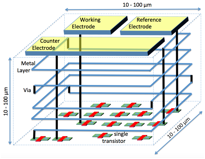Introduction
Imagine an advance in technology that could enable the development of fully drinkable and autonomous bio-electronic CMOS sensors in the form of dust particles, capable of identifying the source of a disease by targeting a specific region in organs and tissue such as a tumor mass and automatically sending diagnostic information wirelessly outside the body. We call this swarm of sensing dust particles ‘Body Dust’. A diagnostic system in the form of Body Dust would need to be small enough to support free circulation in human tissues, which requires a total size of less than 10 μm3, in order to mimic the typical sizes of a blood cell (e.g., white cells have the diameter around 30 μm). Whilst with present state-of-the-art in CMOS technology, this requirement in terms of size is currently un-feasible, recent research has advanced technology such that we can begin to work towards such an approach. Therefore, we propose here to investigate the current limits of CMOS technology as well as the challenges related to the development of such a system.

Project Aim
Towards the above-mentioned goal, this Master project aims to investigate the possibility for remote powering such a system from outside of the body by electromagnetic coupling. The target of the project is to investigate the feasibility of a remote power-data link for a drinkable CMOS diagnostic system, by means of backscattering techniques that can also be exploited for data transmission. Starting from the state-of-the-art analysis in RF versus Acoustic remote power, a preliminary analysis should highlight the trade-offs of such a system and provide the choice among the two options (RF or Acoustic). Then, the project will move to the design of a proper CMOS circuit to implement the energy management for a future prototyping and implementation.
Project Tasks
- Investigate the state-of-the-art of remote power and ultra sounds for miniaturized systems
- Highlight the main trade-offs of possible implementations in terms of power, efficiency, area and range
- Provide a CMOS circuit for a suitable future prototype implementation, including energy storing and voltage regulator
- Perform CADENCE post-layout simulations to assess the performance of the design
Eligibility Requirements:
- Basic knowledge on electromagnetism and acoustic
- Basic knowledge of CAD systems (e.g., CADENCE)
- Interest, Motivation, and Commitment to the project
References
Tracking cancer-cell development with “drinkable” electronic sensors, EPFL News: https://actu.epfl.ch/news/tracking-cancer-cell-development-with-drinkable-el/
Jan Snoeijs, Pantelis Georgiou, and Sandro Carrara, CMOS Body Dust – Towards Drinkable Diagnostics, Proceedings of the International IEEE Conference BioCAS 2017